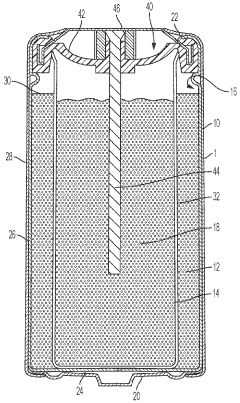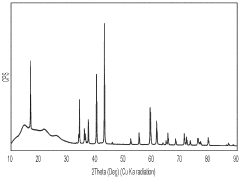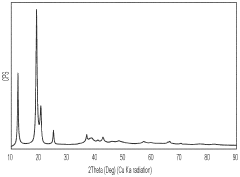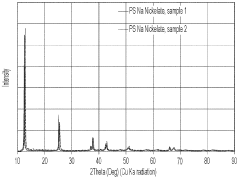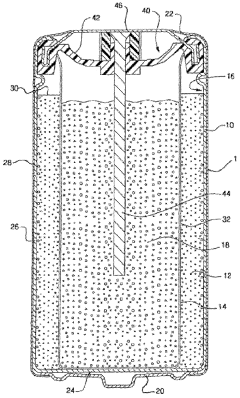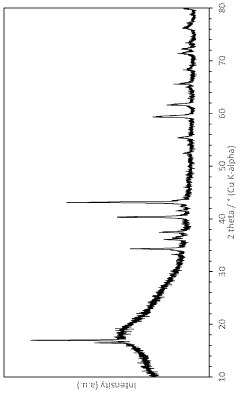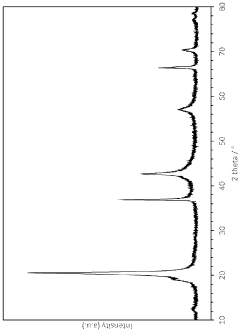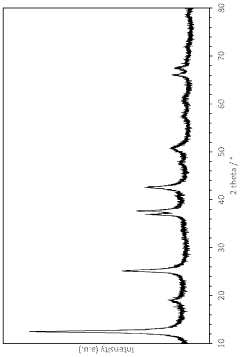Emerging Nichrome Technologies for Battery Efficiency
JUL 11, 20259 MIN READ
Generate Your Research Report Instantly with AI Agent
Patsnap Eureka helps you evaluate technical feasibility & market potential.
Nichrome Battery Tech Evolution and Objectives
Nichrome, an alloy primarily composed of nickel and chromium, has been a subject of increasing interest in the field of battery technology. The evolution of nichrome in battery applications has been driven by the growing demand for more efficient and durable energy storage solutions. Initially used in heating elements due to its high resistance and heat tolerance, nichrome has found new potential in enhancing battery performance.
The development of nichrome technologies for battery efficiency can be traced back to the early 2000s when researchers began exploring alternative materials for battery components. The primary objective was to improve the energy density, cycle life, and thermal stability of batteries, particularly in lithium-ion systems. Nichrome's unique properties, including its excellent corrosion resistance and high melting point, made it an attractive candidate for various battery applications.
One of the key milestones in nichrome battery technology was the introduction of nichrome-coated current collectors. This innovation aimed to enhance the interface between the active material and the current collector, reducing internal resistance and improving overall battery efficiency. Subsequent research focused on optimizing the composition and structure of nichrome alloys to further enhance their performance in battery systems.
The evolution of nichrome in battery technology has also been closely tied to advancements in manufacturing processes. Techniques such as physical vapor deposition (PVD) and electroplating have been refined to create uniform and adherent nichrome coatings on battery components. These improvements have led to better consistency in battery performance and increased durability under various operating conditions.
Recent years have seen a shift towards exploring nichrome-based nanostructures for battery applications. The goal is to leverage the increased surface area and unique properties of nanomaterials to further enhance battery efficiency. This includes the development of nichrome nanowires and nanoparticles as potential additives in electrode materials, aiming to improve conductivity and stability.
Looking forward, the objectives for nichrome battery technology are multifaceted. Researchers are focusing on further optimizing the composition of nichrome alloys to achieve an ideal balance between conductivity, stability, and cost-effectiveness. There is also a growing interest in exploring hybrid systems that combine nichrome with other advanced materials to create synergistic effects in battery performance.
Another key objective is the scalability of nichrome-based battery technologies. As promising results emerge from laboratory studies, efforts are being directed towards translating these innovations into commercially viable products. This involves addressing challenges related to large-scale production, cost reduction, and integration into existing battery manufacturing processes.
The development of nichrome technologies for battery efficiency can be traced back to the early 2000s when researchers began exploring alternative materials for battery components. The primary objective was to improve the energy density, cycle life, and thermal stability of batteries, particularly in lithium-ion systems. Nichrome's unique properties, including its excellent corrosion resistance and high melting point, made it an attractive candidate for various battery applications.
One of the key milestones in nichrome battery technology was the introduction of nichrome-coated current collectors. This innovation aimed to enhance the interface between the active material and the current collector, reducing internal resistance and improving overall battery efficiency. Subsequent research focused on optimizing the composition and structure of nichrome alloys to further enhance their performance in battery systems.
The evolution of nichrome in battery technology has also been closely tied to advancements in manufacturing processes. Techniques such as physical vapor deposition (PVD) and electroplating have been refined to create uniform and adherent nichrome coatings on battery components. These improvements have led to better consistency in battery performance and increased durability under various operating conditions.
Recent years have seen a shift towards exploring nichrome-based nanostructures for battery applications. The goal is to leverage the increased surface area and unique properties of nanomaterials to further enhance battery efficiency. This includes the development of nichrome nanowires and nanoparticles as potential additives in electrode materials, aiming to improve conductivity and stability.
Looking forward, the objectives for nichrome battery technology are multifaceted. Researchers are focusing on further optimizing the composition of nichrome alloys to achieve an ideal balance between conductivity, stability, and cost-effectiveness. There is also a growing interest in exploring hybrid systems that combine nichrome with other advanced materials to create synergistic effects in battery performance.
Another key objective is the scalability of nichrome-based battery technologies. As promising results emerge from laboratory studies, efforts are being directed towards translating these innovations into commercially viable products. This involves addressing challenges related to large-scale production, cost reduction, and integration into existing battery manufacturing processes.
Market Demand for Efficient Battery Solutions
The demand for efficient battery solutions has been steadily increasing across various industries, driven by the growing need for portable electronic devices, electric vehicles, and renewable energy storage systems. As the world transitions towards cleaner energy sources and more sustainable technologies, the market for high-performance batteries continues to expand rapidly.
In the consumer electronics sector, there is a constant push for longer-lasting batteries in smartphones, laptops, and wearable devices. Users expect their devices to operate for extended periods without frequent charging, creating a significant market opportunity for advanced battery technologies. The global smartphone market alone is projected to reach 1.5 billion units by 2025, highlighting the vast potential for improved battery solutions.
The automotive industry represents another major driver of demand for efficient battery technologies. With the shift towards electric vehicles (EVs) gaining momentum, manufacturers are seeking batteries that offer greater energy density, faster charging capabilities, and longer lifespans. The global EV market is expected to grow at a compound annual growth rate (CAGR) of over 20% in the coming years, further intensifying the need for advanced battery solutions.
Renewable energy storage systems also contribute significantly to the market demand for efficient batteries. As countries worldwide increase their reliance on intermittent renewable energy sources like solar and wind, large-scale energy storage becomes crucial for grid stability and reliability. The global energy storage market is forecasted to reach a cumulative 942 GW by 2040, presenting a substantial opportunity for innovative battery technologies.
Industrial applications, including robotics, aerospace, and medical devices, are also fueling the demand for high-performance batteries. These sectors require batteries that can deliver consistent power output, withstand harsh environments, and maintain long operational lifetimes.
The market for efficient battery solutions is not limited to specific regions but is global in nature. Developed economies are driving demand through technological advancements and stringent environmental regulations, while emerging markets are experiencing rapid growth due to increasing electrification and urbanization.
As the demand for efficient battery solutions continues to rise, there is a growing emphasis on developing technologies that not only improve performance but also address environmental concerns. This includes a focus on sustainable materials, recyclability, and reduced carbon footprint throughout the battery lifecycle.
In the consumer electronics sector, there is a constant push for longer-lasting batteries in smartphones, laptops, and wearable devices. Users expect their devices to operate for extended periods without frequent charging, creating a significant market opportunity for advanced battery technologies. The global smartphone market alone is projected to reach 1.5 billion units by 2025, highlighting the vast potential for improved battery solutions.
The automotive industry represents another major driver of demand for efficient battery technologies. With the shift towards electric vehicles (EVs) gaining momentum, manufacturers are seeking batteries that offer greater energy density, faster charging capabilities, and longer lifespans. The global EV market is expected to grow at a compound annual growth rate (CAGR) of over 20% in the coming years, further intensifying the need for advanced battery solutions.
Renewable energy storage systems also contribute significantly to the market demand for efficient batteries. As countries worldwide increase their reliance on intermittent renewable energy sources like solar and wind, large-scale energy storage becomes crucial for grid stability and reliability. The global energy storage market is forecasted to reach a cumulative 942 GW by 2040, presenting a substantial opportunity for innovative battery technologies.
Industrial applications, including robotics, aerospace, and medical devices, are also fueling the demand for high-performance batteries. These sectors require batteries that can deliver consistent power output, withstand harsh environments, and maintain long operational lifetimes.
The market for efficient battery solutions is not limited to specific regions but is global in nature. Developed economies are driving demand through technological advancements and stringent environmental regulations, while emerging markets are experiencing rapid growth due to increasing electrification and urbanization.
As the demand for efficient battery solutions continues to rise, there is a growing emphasis on developing technologies that not only improve performance but also address environmental concerns. This includes a focus on sustainable materials, recyclability, and reduced carbon footprint throughout the battery lifecycle.
Current Nichrome Battery Tech Challenges
Nichrome battery technology, while promising for its potential to enhance energy storage efficiency, currently faces several significant challenges that impede its widespread adoption and commercialization. One of the primary obstacles is the high cost associated with nichrome materials, particularly when compared to traditional battery components. This cost factor limits the economic viability of nichrome batteries in many applications, especially in consumer electronics and electric vehicles where price sensitivity is a crucial consideration.
Another major challenge lies in the scalability of nichrome battery production. Current manufacturing processes for nichrome-based batteries are complex and not easily adaptable to large-scale production. This limitation hinders the ability to meet potential market demand and achieve economies of scale, further exacerbating the cost issue.
The stability and longevity of nichrome batteries also present significant technical hurdles. While nichrome offers excellent conductivity and heat resistance, its long-term performance in battery applications is still under scrutiny. Issues such as capacity fade over multiple charge-discharge cycles and potential degradation of nichrome components under certain operating conditions need to be addressed to ensure the reliability and durability of these batteries.
Safety concerns represent another critical challenge in nichrome battery technology. The high operating temperatures often associated with nichrome components raise questions about thermal management and the potential for thermal runaway. Developing robust safety mechanisms and cooling systems is essential to mitigate these risks and gain consumer and regulatory confidence.
Furthermore, the integration of nichrome technology with existing battery management systems and charging infrastructure poses significant technical challenges. Compatibility issues with current battery technologies and the need for specialized charging protocols may limit the immediate applicability of nichrome batteries in various sectors.
Environmental considerations also play a role in the challenges faced by nichrome battery technology. While nichrome itself is relatively inert, the overall environmental impact of nichrome battery production, use, and disposal needs thorough assessment. Developing sustainable manufacturing processes and effective recycling methods for nichrome batteries is crucial for their long-term viability and acceptance.
Lastly, the regulatory landscape for nichrome battery technology remains uncertain in many jurisdictions. The lack of specific standards and regulations for this emerging technology can create barriers to market entry and slow down adoption rates. Establishing clear regulatory frameworks and safety standards is essential for the future growth and acceptance of nichrome battery technology in various applications.
Another major challenge lies in the scalability of nichrome battery production. Current manufacturing processes for nichrome-based batteries are complex and not easily adaptable to large-scale production. This limitation hinders the ability to meet potential market demand and achieve economies of scale, further exacerbating the cost issue.
The stability and longevity of nichrome batteries also present significant technical hurdles. While nichrome offers excellent conductivity and heat resistance, its long-term performance in battery applications is still under scrutiny. Issues such as capacity fade over multiple charge-discharge cycles and potential degradation of nichrome components under certain operating conditions need to be addressed to ensure the reliability and durability of these batteries.
Safety concerns represent another critical challenge in nichrome battery technology. The high operating temperatures often associated with nichrome components raise questions about thermal management and the potential for thermal runaway. Developing robust safety mechanisms and cooling systems is essential to mitigate these risks and gain consumer and regulatory confidence.
Furthermore, the integration of nichrome technology with existing battery management systems and charging infrastructure poses significant technical challenges. Compatibility issues with current battery technologies and the need for specialized charging protocols may limit the immediate applicability of nichrome batteries in various sectors.
Environmental considerations also play a role in the challenges faced by nichrome battery technology. While nichrome itself is relatively inert, the overall environmental impact of nichrome battery production, use, and disposal needs thorough assessment. Developing sustainable manufacturing processes and effective recycling methods for nichrome batteries is crucial for their long-term viability and acceptance.
Lastly, the regulatory landscape for nichrome battery technology remains uncertain in many jurisdictions. The lack of specific standards and regulations for this emerging technology can create barriers to market entry and slow down adoption rates. Establishing clear regulatory frameworks and safety standards is essential for the future growth and acceptance of nichrome battery technology in various applications.
Existing Nichrome Battery Efficiency Solutions
01 Nichrome heating element efficiency
Nichrome alloys are widely used in heating elements due to their high electrical resistance and heat tolerance. Improving the efficiency of nichrome heating elements involves optimizing their design, such as adjusting the wire thickness and coil spacing, to achieve better heat distribution and energy utilization.- Nichrome heating element efficiency: Nichrome alloys are widely used in heating elements due to their high electrical resistance and heat-generating properties. Improvements in nichrome technology focus on enhancing the efficiency of these heating elements by optimizing their composition, structure, and design. This results in better heat distribution, reduced power consumption, and increased overall performance in various applications.
- Nichrome-based sensors and measurement devices: Nichrome is utilized in the development of efficient sensors and measurement devices. Its stable electrical properties and temperature resistance make it suitable for applications in temperature sensing, flow measurement, and other precision instruments. Advancements in nichrome technology contribute to improved accuracy, reliability, and longevity of these devices.
- Nichrome thin film technology: Nichrome thin films are employed in various electronic and optical applications. Research focuses on enhancing the efficiency of these films by improving their deposition techniques, controlling their thickness, and optimizing their composition. This leads to better performance in applications such as resistive elements, optical coatings, and microelectronic devices.
- Nichrome alloy composition optimization: Ongoing research aims to optimize the composition of nichrome alloys to enhance their efficiency and performance. By adjusting the ratios of nickel, chromium, and other elements, researchers can tailor the alloy's properties for specific applications. This results in improved electrical resistance, thermal stability, and corrosion resistance, leading to more efficient and durable nichrome-based technologies.
- Nichrome in energy-efficient systems: Nichrome technologies are integrated into energy-efficient systems and devices. The material's unique properties are leveraged to develop more efficient heating systems, energy storage solutions, and power management devices. These advancements contribute to overall energy conservation and improved performance in various industrial and consumer applications.
02 Nichrome thin film technology
Nichrome thin films are utilized in various electronic applications, including resistors and sensors. The efficiency of these thin films can be enhanced by controlling the deposition process, film thickness, and composition to achieve desired electrical properties and stability.Expand Specific Solutions03 Nichrome alloy composition optimization
The efficiency of nichrome technologies can be improved by optimizing the alloy composition. This involves adjusting the ratio of nickel and chromium, as well as incorporating additional elements to enhance specific properties such as oxidation resistance, thermal stability, and electrical conductivity.Expand Specific Solutions04 Nichrome-based sensor efficiency
Nichrome alloys are used in various sensing applications due to their stable electrical properties. Improving the efficiency of nichrome-based sensors involves enhancing their sensitivity, response time, and accuracy through innovative designs and manufacturing techniques.Expand Specific Solutions05 Nichrome coating technology
Nichrome coatings are applied to various substrates to impart specific properties such as wear resistance and electrical conductivity. Enhancing the efficiency of nichrome coating technologies involves improving adhesion, uniformity, and durability through advanced deposition techniques and surface preparation methods.Expand Specific Solutions
Key Players in Nichrome Battery Industry
The emerging nichrome technologies for battery efficiency market is in its early growth stage, characterized by rapid innovation and increasing competition. The market size is expanding as demand for more efficient batteries grows across various industries. While the technology is still evolving, several key players are making significant strides in research and development. Companies like BYD Co., Ltd., LG Energy Solution Ltd., and Contemporary Amperex Technology Co., Ltd. are at the forefront, leveraging their expertise in battery manufacturing to advance nichrome technologies. Research institutions such as Beijing Institute of Technology and Tianjin University are contributing to the scientific advancements. The involvement of established players like 3M Innovative Properties Co. and emerging startups like EnPower, Inc. indicates a diverse and dynamic competitive landscape, with varying levels of technological maturity among participants.
BYD Co., Ltd.
Technical Solution: BYD has developed a novel nichrome-based cathode coating technology for their Blade Battery series. This innovation involves applying a thin layer of nichrome alloy to the surface of lithium iron phosphate (LFP) cathode particles, enhancing their conductivity and stability. The nichrome coating acts as a protective barrier, reducing unwanted side reactions between the cathode and electrolyte, thereby extending battery life and improving safety[12]. BYD's nichrome-enhanced Blade Batteries have demonstrated a 50% increase in energy density compared to traditional LFP batteries, while maintaining excellent thermal stability and low risk of thermal runaway[13]. The company has also integrated this technology into their cell-to-pack design, further optimizing space utilization and overall battery performance in electric vehicles.
Strengths: Improved energy density, enhanced safety, and compatibility with existing LFP production processes. Weaknesses: Potential increase in raw material costs and complexity in quality control during manufacturing.
LG Energy Solution Ltd.
Technical Solution: LG Energy Solution has developed advanced nichrome-based cathode materials for lithium-ion batteries. Their technology incorporates a unique nickel-rich layered oxide structure, which enhances energy density and thermal stability. The company has achieved a 90% nickel content in their NCM (Nickel Cobalt Manganese) cathodes[1], significantly improving battery capacity. They've also implemented a proprietary coating process using nichrome alloys to create a protective layer on cathode particles, reducing unwanted side reactions and extending battery life[2]. This innovation has led to batteries with energy densities exceeding 700 Wh/L[3], pushing the boundaries of electric vehicle range and performance.
Strengths: High energy density, improved thermal stability, and extended battery life. Weaknesses: Potential higher production costs and complexity in manufacturing processes.
Core Nichrome Battery Innovations
Sodium nickelate cathode material synthesis utilizing persulfate desodiation and oxidation and uses thereof
PatentWO2023201110A1
Innovation
- A method involving persulfate desodiation and oxidation of sodium nickelate is developed to produce a more stable nickelate material with improved chemical stability and yield, which is then combined with electrolytic manganese dioxide and graphite in an alkaline cathode composition, along with pre-aging processes to enhance stability further.
Pre-aged sodium nickelate cathode materials and uses thereof
PatentWO2023201112A1
Innovation
- A pre-aged desodiated nickelate material with specific X-ray diffraction patterns is produced through acid leaching and pre-aging with a hydroxide solution, enhancing chemical stability and stability in aqueous electrolytes.
Environmental Impact of Nichrome Batteries
The environmental impact of nichrome batteries is a critical consideration in the development and adoption of emerging battery technologies. As nichrome alloys gain prominence in battery applications, their potential effects on ecosystems and human health must be thoroughly evaluated.
Nichrome, primarily composed of nickel and chromium, offers several advantages in battery design, including high temperature resistance and improved electrical conductivity. However, the extraction and processing of these metals can have significant environmental consequences. Mining operations for nickel and chromium often lead to habitat destruction, soil erosion, and water pollution. The energy-intensive refining processes contribute to increased carbon emissions, exacerbating climate change concerns.
During the battery manufacturing phase, the production of nichrome components may involve the use of hazardous chemicals and generate toxic waste. Proper handling and disposal of these materials are essential to prevent contamination of soil and water resources. Additionally, the manufacturing process itself consumes substantial energy, further contributing to the carbon footprint of nichrome batteries.
The operational phase of nichrome batteries presents both opportunities and challenges from an environmental perspective. On the positive side, their enhanced efficiency and longer lifespan compared to traditional battery technologies can lead to reduced waste generation and resource consumption over time. However, the potential for leaching of heavy metals, particularly nickel and chromium, into the environment during use or improper disposal remains a significant concern.
End-of-life management of nichrome batteries is crucial for mitigating their environmental impact. Recycling processes for these batteries must be developed and optimized to recover valuable materials and prevent the release of harmful substances into the environment. However, the complex composition of nichrome alloys may present challenges in achieving high recycling rates and may require the development of specialized recycling technologies.
The long-term environmental effects of widespread nichrome battery adoption are still being studied. Potential impacts on biodiversity, soil quality, and water systems need to be carefully monitored and assessed. As the technology evolves, ongoing research into more environmentally friendly alternatives and improved recycling methods will be essential to minimize the ecological footprint of nichrome batteries.
In conclusion, while nichrome batteries offer promising advancements in energy storage efficiency, their environmental impact must be carefully managed throughout their lifecycle. Balancing the benefits of improved battery performance with the need for sustainable practices will be crucial in determining the role of nichrome technologies in future energy solutions.
Nichrome, primarily composed of nickel and chromium, offers several advantages in battery design, including high temperature resistance and improved electrical conductivity. However, the extraction and processing of these metals can have significant environmental consequences. Mining operations for nickel and chromium often lead to habitat destruction, soil erosion, and water pollution. The energy-intensive refining processes contribute to increased carbon emissions, exacerbating climate change concerns.
During the battery manufacturing phase, the production of nichrome components may involve the use of hazardous chemicals and generate toxic waste. Proper handling and disposal of these materials are essential to prevent contamination of soil and water resources. Additionally, the manufacturing process itself consumes substantial energy, further contributing to the carbon footprint of nichrome batteries.
The operational phase of nichrome batteries presents both opportunities and challenges from an environmental perspective. On the positive side, their enhanced efficiency and longer lifespan compared to traditional battery technologies can lead to reduced waste generation and resource consumption over time. However, the potential for leaching of heavy metals, particularly nickel and chromium, into the environment during use or improper disposal remains a significant concern.
End-of-life management of nichrome batteries is crucial for mitigating their environmental impact. Recycling processes for these batteries must be developed and optimized to recover valuable materials and prevent the release of harmful substances into the environment. However, the complex composition of nichrome alloys may present challenges in achieving high recycling rates and may require the development of specialized recycling technologies.
The long-term environmental effects of widespread nichrome battery adoption are still being studied. Potential impacts on biodiversity, soil quality, and water systems need to be carefully monitored and assessed. As the technology evolves, ongoing research into more environmentally friendly alternatives and improved recycling methods will be essential to minimize the ecological footprint of nichrome batteries.
In conclusion, while nichrome batteries offer promising advancements in energy storage efficiency, their environmental impact must be carefully managed throughout their lifecycle. Balancing the benefits of improved battery performance with the need for sustainable practices will be crucial in determining the role of nichrome technologies in future energy solutions.
Nichrome Battery Manufacturing Processes
Nichrome battery manufacturing processes have evolved significantly in recent years, driven by the demand for more efficient and cost-effective energy storage solutions. The production of nichrome-based batteries involves several key stages, each crucial for ensuring optimal performance and longevity.
The first step in the manufacturing process is the preparation of the nichrome alloy. This typically involves precise mixing of nickel and chromium in specific ratios, often with small amounts of other elements added to enhance certain properties. The alloy is then melted and cast into ingots or sheets, depending on the intended application.
Next, the nichrome material undergoes a series of shaping and forming processes. These may include rolling, drawing, or extrusion to create the desired form factor for battery components. Advanced techniques such as powder metallurgy are sometimes employed to achieve specific microstructures that can improve battery performance.
Surface treatment is a critical phase in the manufacturing process. Various methods, including chemical etching, electropolishing, and plasma treatment, are used to modify the surface properties of the nichrome components. These treatments enhance the material's conductivity, corrosion resistance, and overall electrochemical performance within the battery system.
The assembly of nichrome-based battery cells requires precision engineering. Automated systems are often employed to ensure consistent placement and connection of components. This stage may involve the integration of nichrome electrodes with other materials such as separators and electrolytes, all carefully designed to work in synergy.
Quality control measures are implemented throughout the manufacturing process. This includes rigorous testing of material properties, dimensional accuracy, and electrochemical performance. Advanced imaging techniques and in-line monitoring systems are used to detect defects and ensure adherence to strict quality standards.
The final stages of production involve packaging and conditioning of the battery cells. This may include the formation of battery packs, installation of battery management systems, and initial charging cycles to prepare the batteries for optimal performance in their intended applications.
Emerging technologies in nichrome battery manufacturing are focused on improving energy density, cycle life, and production efficiency. Innovations in nanotechnology are being explored to create advanced nichrome-based electrode structures with enhanced surface area and reactivity. Additionally, research into novel alloy compositions and manufacturing techniques aims to further optimize the performance characteristics of nichrome batteries.
The first step in the manufacturing process is the preparation of the nichrome alloy. This typically involves precise mixing of nickel and chromium in specific ratios, often with small amounts of other elements added to enhance certain properties. The alloy is then melted and cast into ingots or sheets, depending on the intended application.
Next, the nichrome material undergoes a series of shaping and forming processes. These may include rolling, drawing, or extrusion to create the desired form factor for battery components. Advanced techniques such as powder metallurgy are sometimes employed to achieve specific microstructures that can improve battery performance.
Surface treatment is a critical phase in the manufacturing process. Various methods, including chemical etching, electropolishing, and plasma treatment, are used to modify the surface properties of the nichrome components. These treatments enhance the material's conductivity, corrosion resistance, and overall electrochemical performance within the battery system.
The assembly of nichrome-based battery cells requires precision engineering. Automated systems are often employed to ensure consistent placement and connection of components. This stage may involve the integration of nichrome electrodes with other materials such as separators and electrolytes, all carefully designed to work in synergy.
Quality control measures are implemented throughout the manufacturing process. This includes rigorous testing of material properties, dimensional accuracy, and electrochemical performance. Advanced imaging techniques and in-line monitoring systems are used to detect defects and ensure adherence to strict quality standards.
The final stages of production involve packaging and conditioning of the battery cells. This may include the formation of battery packs, installation of battery management systems, and initial charging cycles to prepare the batteries for optimal performance in their intended applications.
Emerging technologies in nichrome battery manufacturing are focused on improving energy density, cycle life, and production efficiency. Innovations in nanotechnology are being explored to create advanced nichrome-based electrode structures with enhanced surface area and reactivity. Additionally, research into novel alloy compositions and manufacturing techniques aims to further optimize the performance characteristics of nichrome batteries.
Unlock deeper insights with Patsnap Eureka Quick Research — get a full tech report to explore trends and direct your research. Try now!
Generate Your Research Report Instantly with AI Agent
Supercharge your innovation with Patsnap Eureka AI Agent Platform!
